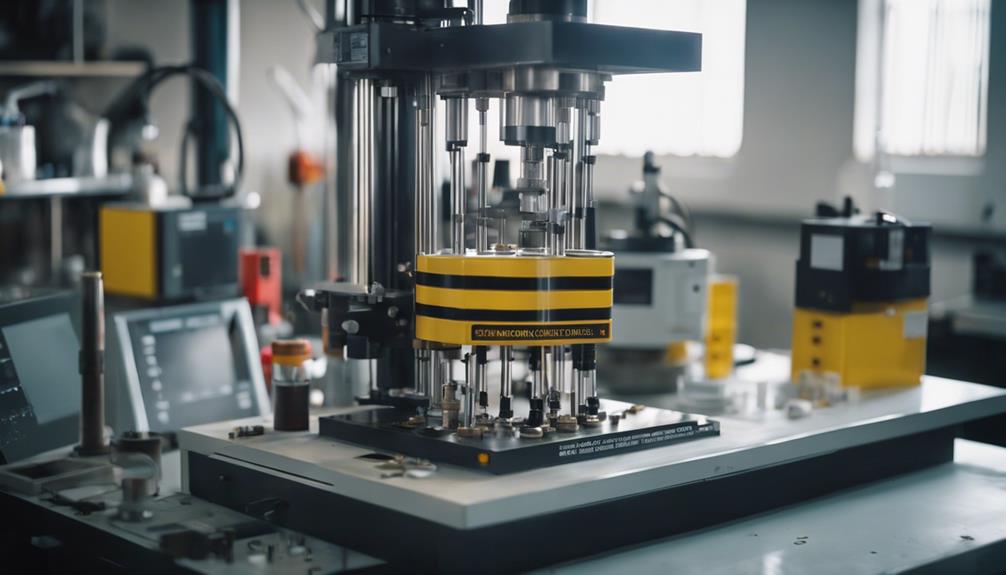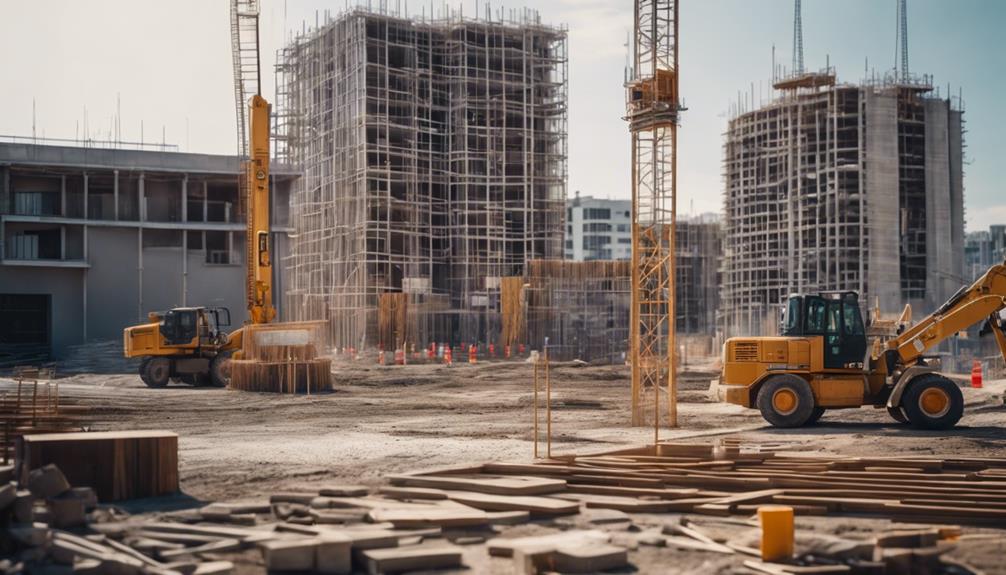Safety and strength are top priorities when it comes to building! Here are five easy steps to make sure your building materials are top-notch.
First, get to know your material's strength. This is like finding out how much weight a material can handle.
Next, use two tests called the Slump Test Method and the Vee-Bee Consistometer. These help check the quality of your concrete.
The third step is the Sieve Analysis. This helps you find out the right sizes for your building materials.
Last but not least, watch your mixing proportions. This means making sure you have the right amounts of each material.
These steps are super important and can help make your building project a success. So, are you ready to discover how helpful they can be? Let's dive in!
Key Takeaways
- The Slump Test Method is like making a sandcastle: you fill a cone-shaped mold with fresh concrete and then see how much it slumps or droops. This can tell us a lot about the concrete's quality.
- The Vee-Bee Consistometer is like a stopwatch for concrete. It measures how long it takes for a shaking table to reach a certain level of movement with the concrete on it.
- Imagine using different-sized kitchen sieves to sort your favorite cereals by size. That's what Sieve Analysis does with building materials, especially aggregates, to help choose the right ones.
- Monitoring Mixing Proportions is like baking a cake. You need the right amount of ingredients – in this case, stone, cement, and water – for a perfect mixture.
- Comprehensive Strength Testing is like a fitness test for building materials. It checks if they're strong enough to carry weight and withstand different conditions, which makes buildings safer and last longer.
Understanding Material Comprehensive Strength
Knowing how strong building materials are is super important when you want to build something that's safe and lasts a long time. It's like being a detective, testing how much weight a material can handle before it breaks. Sounds a bit scary, right? But it's a must-do. This important step gives us helpful info for designing safe buildings.
Testing materials is like going on an adventure to uncover what makes a building stand tall and brave. It's not fun to see a material fail, but it's part of the process. The info we get from these tests helps engineers pick the right stuff for different jobs. It's not just about building something that stands, it's about making something that can fight off rust and withstand the elements.
Knowing how strong a material is, is super crucial. It's like the secret ingredient in making sure your building project is strong and trustworthy. So don't shy away from the truth that these tests reveal. In the world of building, what's inside a material is what really matters.
The Slump Test Method
The slump test method is a cool way builders check if fresh concrete is good or not. Think of it like a report card for concrete. It tells us if the concrete is ready to be used for building strong and long-lasting structures.
So, what happens in this test? It's pretty simple. A builder fills a cone-shaped mold with concrete and then lifts it up. The way the concrete falls or 'slumps' tells us a lot about it. It's like the concrete is talking to us! It tells us if it has the right amount of water, the size of the bits in it, and if it's mixed right.
But, the test is more than just watching the concrete slump. How much it slumps is a strong sign of the concrete's quality. It helps us know if the concrete is good enough to use for building. Isn't that interesting?
The results of this test help builders make changes to the concrete mix. This makes sure that the concrete is perfect for building stuff.
Knowing the slump test method helps us feel closer to the materials we use for building. It's not just about knowing technical stuff, it's also about making sure that what we build will last a long time. After all, building isn't just about making structures, it's about creating places where people feel they belong.
Vee-Bee Consistometer Explained

Think of the Vee-Bee Consistometer as a magic tool that helps you understand concrete better. It's a device that checks if the concrete we use in building things is good and easy to work with.
This tool tests the concrete by measuring how long it takes for a shaking table to reach a certain movement level. The results can tell you if the concrete mix needs to be adjusted to work better.
Ensuring good quality in building work is very important. That's where the Vee-Bee Consistometer comes in. It makes sure your concrete is good enough for your building project. So, using the Vee-Bee Consistometer can help you do a great job in building. Remember, having good quality materials is the most important thing in construction work.
Sieve Analysis: A Vital Process
Sieve analysis is a super useful process for people in the building industry, like you. It's a simple test that helps you figure out what sizes your building materials are, especially aggregates, which are like small bits of rock. You do this by passing a sample of your materials through a set of sieves, each with smaller and smaller holes.
This method is pretty important because it helps you sort your materials by size. It's a key part of testing in the building world.
The info you get from this test is critical. It helps you choose the right materials for making concrete and checks if they're good for different building uses. With sieve analysis, you won't be guessing anymore. It helps you understand the mix of big and small particles in your materials.
You use sieves with specific mesh sizes in this process. This lets you sort the particles effectively during the test. This careful way of sorting not only makes your materials work better but also improves the overall quality of your building projects.
In short, sieve analysis is a must-know process in the building field. It gives you a clear picture of your materials, helping you make smart choices. If you use it, you'll join a group of builders who focus on quality and accuracy in all their projects.
Monitoring Mixing Proportions Effectively

In the world of building stuff, it's really important to keep an eye on how you mix your materials. If you don't, your building mightn't be as strong or last as long. So, what's the secret to making sure your materials are top-notch?
Firstly, you need to test them. This means checking how much of each thing – like stone, cement, and water – you're using. If you get these amounts just right, your building will stay strong and last a long time. Plus, it'll help stop problems like the materials separating or becoming too runny.
Keeping an eye on how you mix your stuff doesn't just make sure your building turns out great. It also helps everyone feel good about the project. Your team, the people who care about the project, and the people you're building for will all see that you care about doing a good job. When you follow the rules, everyone feels like they're part of something that's going to be great.
Don't let your project fall apart because you didn't mix your materials right. Remember, as a builder, you're not just making a building. You're also building trust, honesty, and a sense of community. So, make sure you're always watching how you mix your materials to make sure they're the best they can be.
Conclusion
You now know the top 5 ways to make sure your construction materials are top-notch. These include checking out the overall toughness of the materials, the slump test, and the Vee-Bee consistometer.
You can also use sieve analysis and keep an eye on how much of each material you mix together. These tools will help you make sure your building materials are the best they can be.
Remember, using good quality materials is really important. So, don't be shy to use these tricks to make sure your construction project lasts a long time!


